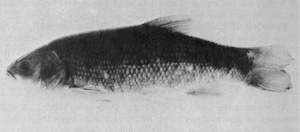- Thicktail chub
Taxobox
name = Thicktail chub
status = EX | status_system = IUCN2.3
extinct = 1950s

image_width = 250px
image_caption =
regnum =Animal ia
phylum = Chordata
classis =Actinopterygii
ordo =Cypriniformes
familia =Cyprinidae
genus = "Gila"
species = "G. crassicauda"
binomial = "Gila crassicauda"The Thicktail chub ("Gila crassicauda") was a type of
minnow that inhabited the lowlands and weedy backwaters of the Sacramento andSan Joaquin River s in the Central Valley ofCalifornia . It was once abundant in lowlandlake s,marsh es,pond s, slow-moving stretches of river, and, during years of heavy run-off, the surface waters ofSan Francisco Bay . The thicktail chub was one of the most common fish in California; at the turn of the 20th century it comprised over 40% of the fish population of the Sacramento River.The chub was a favored food of the native Indian peoples of
Clear Lake and the Central Valley before being heavily exploited by commercial fishermen supplying the San Francisco market. A heavy-bodied fish with a thick tail and a small, cone-shaped head, the backs of the thicktail chub ranged in color from greenish-brown to purplish black, while the sides and belly were yellow. It could reach a length of nearly ten inches. Although little is known about its behavior, it was probably carnivorous, feeding on small fish andinvertebrate s.The primary cause of the thicktailed chub’s extinction was the conversion of much of the Central Valley to agricultural use. Most of its habitat was destroyed by the drainage of sloughs and marshes, dam-building, and water diversion for irrigation. All this resulted in the loss of the sluggish water the species preferred. Competition from exotic species and hybridization with the introduced
Hitch minnow also contributed to its extinction. The last known example was caught in the late 1950s.References
*
Wikimedia Foundation. 2010.
